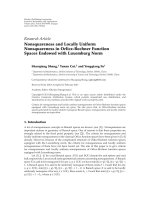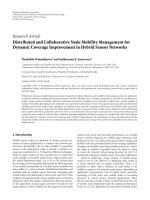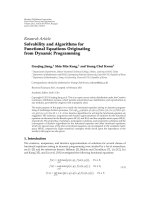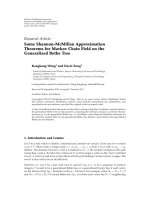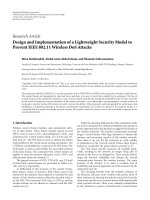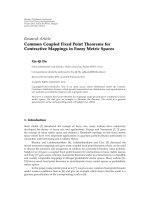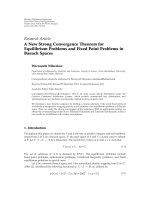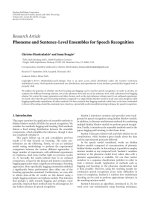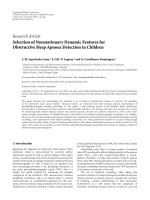Báo cáo hóa học: " Research Article Weak and Strong Convergence Theorems for Asymptotically Strict Pseudocontractive Mappings in the Intermediate Sense" pptx
Bạn đang xem bản rút gọn của tài liệu. Xem và tải ngay bản đầy đủ của tài liệu tại đây (512.97 KB, 13 trang )
Hindawi Publishing Corporation
Fixed Point Theory and Applications
Volume 2010, Article ID 281070, 13 pages
doi:10.1155/2010/281070
Research Article
Weak and Strong Convergence Theorems for
Asymptotically Strict Pseudocontractive Mappings
in the Intermediate Sense
Jing Zhao
1, 2
and Songnian He
1, 2
1
College of Science, Civil Aviation University of China, Tianjin 300300, China
2
Tianjin Key Laboratory For Advanced Signal Processing, Civil Aviation University of China,
Tianjin 300300, China
Correspondence should be addressed to Jing Zhao,
Received 23 June 2010; Accepted 19 October 2010
Academic Editor: W. A. Kirk
Copyright q 2010 J. Zhao and S. He. This is an open access article distributed under the Creative
Commons Attribution License, which permits unrestricted use, distribution, and reproduction in
any medium, provided the original work is properly cited.
We study the convergence of Ishikawa iteration process for the class of asymptotically κ-strict
pseudocontractive mappings in the intermediate sense which is not necessarily Lipschitzian. Weak
convergence theorem is established. We also obtain a strong convergence theorem by using hybrid
projection for this iteration process. Our results improve and extend the corresponding results
announced by many others.
1. Introduction and Preliminaries
Throughout this paper, we always assume that H is a real Hilbert space with inner product
·, · and norm ·.and → denote weak and strong convergence, respectively. ω
w
x
n
denotes the weak ω-limit set of {x
n
},thatis,ω
w
x
n
{x ∈ H : ∃x
n
j
x}.LetC be a
nonempty closed convex subset of H. It is well known that for every point x ∈ H, there exists
a unique nearest point in C, denoted by P
C
x, such that
x − P
C
x
≤
x − y
, 1.1
for all y ∈ C. P
C
is called the metric projection of H onto C. P
C
is a nonexpansive mapping of
H onto C and satisfies
x − y, P
C
x − P
C
y
≥
P
C
x − P
C
y
2
, ∀x, y ∈ H.
1.2
2 Fixed Point Theory and Applications
Let T : C → C be a mapping. In this paper, we denote the fixed point set of T by FT.
Recall that T is said to be uniformly L-Lipschitzian if there exists a constant L>0, such that
T
n
x − T
n
y
≤ L
x − y
, ∀x, y ∈ C, ∀n ≥ 1. 1.3
T is said to be nonexpansive if
Tx − Ty
≤
x − y
, ∀x, y ∈ C. 1.4
T is said to be asymptotically nonexpansive if there exists a sequence {k
n
} in 1, ∞ with
lim
n →∞
k
n
1, such that
T
n
x − T
n
y
≤ k
n
x − y
, ∀x, y ∈ C, ∀n ≥ 1. 1.5
The class of asymptotically nonexpansive mappings was introduced by Goebel and Kirk 1
as a generalization of the class of nonexpansive mappings. T is said to be asymptotically
nonexpansive in the intermediate sense if it is continuous and the following inequality holds:
lim sup
n →∞
sup
x,y∈C
T
n
x − T
n
y
−
x − y
≤ 0.
1.6
Observe that if we define
τ
n
max
0, sup
x,y∈C
T
n
x − T
n
y
−
x − y
,
1.7
then τ
n
→ 0asn →∞. It follows that 1.6 is reduced to
T
n
x − T
n
y
≤
x − y
τ
n
, ∀x, y ∈ C, ∀n ≥ 1. 1.8
The class of mappings which are asymptotically nonexpansive in the intermediate sense was
introduced by Bruck et al. 2. It is known 3 that if C is a nonempty closed convex bounded
subset of a uniformly convex Banach space E and T is asymptotically nonexpansive in the
intermediate sense, then T has a fixed point. It is worth mentioning that the class of mappings
which are asymptotically nonexpansive in the intermediate sense contains properly the class
of asymptotically nonexpansive mappings.
Recall that T is said to be a κ-strict pseudocontraction if there exists a constant κ ∈
0, 1, such that
Tx − Ty
2
≤
x − y
2
κ
I − Tx − I − Ty
2
, ∀x, y ∈ C.
1.9
Fixed Point Theory and Applications 3
T is said to be an asymptotically κ-strict pseudocontraction with sequence {γ
n
} if there exist
a constant κ ∈ 0, 1 and a sequence {γ
n
}⊂0, ∞ with γ
n
→ 0asn →∞, such that
T
n
x − T
n
y
2
≤
1 γ
n
x − y
2
κ
I − T
n
x − I −T
n
y
2
, ∀x, y ∈ C, n ≥ 1.
1.10
The class of asymptotically κ-strict pseudocontractions was introduced by Qihou 4 in 1996
see also 5.KimandXu6 studied weak and strong convergence theorems for this class
of mappings. It is important to note that every asymptotically κ-strict pseudocontractive
mapping with sequence {γ
n
} is a uniformly L-Lipschitzian mapping with L sup{κ
1 1 − κγ
n
/1 κ : n ∈ N}.
Recently, Sahu et al. 7 introduced a class of new mappings: asymptotically κ-
strict pseudocontractive mappings in the intermediate sense. Recall that T is said to be an
asymptotically κ-strict pseudocontraction in the intermediate sense with sequence {γ
n
} if
there exist a constant κ ∈ 0, 1 and a sequence {γ
n
}⊂0, ∞ with γ
n
→ 0asn →∞,
such that
lim sup
n →∞
sup
x,y∈C
T
n
x − T
n
y
2
−
1 γ
n
x − y
2
− κ
I − T
n
x −
I − T
n
y
2
≤ 0.
1.11
Throughout this paper, we assume that
c
n
max
0, sup
x,y∈C
T
n
x − T
n
y
2
−
1 γ
n
x − y
2
− κ
I − T
n
x −
I − T
n
y
2
.
1.12
It follows that c
n
→ 0asn →∞and 1.11 is reduced to the relation
T
n
x − T
n
y
2
≤
1 γ
n
x − y
2
κ
I − T
n
x − I −T
n
y
2
c
n
, ∀x, y ∈ C.
1.13
They obtained a weak convergence theorem of modified Mann iterative processes for the class
of mappings which is not necessarily Lipschitzian. Moreover, a strong convergence theorem
was also established in a real Hilbert space by hybrid projection methods; see 7 for more
details.
In this paper, we consider the problem of convergence of Ishikawa iterative processes
for the class of asymptotically κ-strict pseudocontractive mappings in the intermediate sense.
In order to prove our main results, we also need the following lemmas.
Lemma 1.1 see 8, 9. Let {δ
n
}, {β
n
}, and {γ
n
} be three sequences of nonnegative numbers
satisfying the recursive inequality
δ
n1
≤ β
n
δ
n
γ
n
, ∀n ≥ 1. 1.14
If β
n
≥ 1,
∞
n1
β
n
− 1 < ∞ and
∞
n1
γ
n
< ∞,thenlim
n →∞
δ
n
exists.
4 Fixed Point Theory and Applications
Lemma 1.2 see 10. Let {x
n
} be a bounded sequence in a reflexive Banach space X.Ifω
w
x
n
{x},thenx
n
x.
Lemma 1.3 see 11. Let C be a nonempty closed convex subset of a real Hilbert space H.Given
x ∈ H and z ∈ C,thenz P
C
x if and only if x − z, y − z≤0, for all y ∈ C.
Lemma 1.4 see 11. For a real Hilbert space H, the following identities hold:
i x −y
2
x
2
−y
2
− 2x − y, y, for all x, y ∈ H,
ii tx 1 − ty
2
tx
2
1−ty
2
−t1−tx −y
2
, for all t ∈ 0, 1, for all x, y ∈ H;
iii (Opial condition) If {x
n
} is a sequence in H weakly convergent to z,then
lim sup
n →∞
x
n
− y
2
lim sup
n →∞
x
n
− z
2
z − y
2
, ∀y ∈ H.
1.15
Lemma 1.5 see 7. Let C be a nonempty subset of a Hilbert space H and T : C → C an
asymptotically κ-strict pseudocontractive mapping in the intermediate sense with sequence {γ
n
}.Then
T
n
x − T
n
y
≤
1
1 − κ
κ
x − y
1
1 − κ
γ
n
x − y
2
1 − κ
c
n
,
∀x, y ∈ C, ∀n ∈ N.
1.16
Lemma 1.6. Let C be a nonempty subset of a Hilbert space H and T : C → C an asymptotically
κ-strict pseudocontractive mapping in the intermediate sense with sequence {γ
n
}.Letn ∈ N.Ifγ
n
< 1,
then
T
n
x − T
n
y
≤
1
1 − κ
κ
√
2 − κ
x − y
√
c
n
, ∀x, y ∈ C.
1.17
Proof. If γ
n
< 1, for x, y ∈ C,weobtainfromLemma 1.5 that
T
n
x − T
n
y
≤
1
1 − κ
κ
x − y
1
1 − κ
γ
n
x − y
2
1 − κ
c
n
≤
1
1 − κ
κ
x − y
2 − κ
x − y
2
c
n
≤
1
1 − κ
κ
x − y
√
2 − κ
x − y
√
c
n
2
1
1 − κ
κ
√
2 − κ
x − y
√
c
n
.
1.18
Lemma 1.7 see 7. Let C be a nonempty subset of a Hilbert space H and T : C → C a uniformly
continuous asymptotically κ-strict pseudocontractive mapping in the intermediate sense with sequence
{γ
n
}.Let{x
n
} be a sequence in C such that x
n
− x
n1
→0 and x
n
− T
n
x
n
→0 as n →∞,
then x
n
− Tx
n
→0 as n →∞.
Fixed Point Theory and Applications 5
Lemma 1.8 see 7,Proposition3.1. Let C be a nonempty closed convex subset of a Hilbert
space H and T : C → C a continuous asymptotically κ-strict pseudocontractive mapping in the
intermediate sense. Then I − T is demiclosed at zero in the sense that if {x
n
} is a sequence in C such
that x
n
x∈ C and lim sup
m →∞
lim sup
n →∞
x
n
− T
m
x
n
0,thenI − Tx 0.
Lemma 1.9 see 7. Let C be a nonempty closed convex subset of a Hilbert space H and T : C → C
a continuous asymptotically κ-strict pseudocontractive mapping in the intermediate sense. Then FT
is closed and convex.
2. Main Results
Theorem 2.1. Let C be a nonempty closed convex subset of a Hilbert space H and T : C → C
a uniformly continuous asymptotically κ-strict pseudocontractive mapping in the intermediate sense
with sequence {γ
n
} such that FT
/
∅.Let{x
n
}
∞
n1
be a sequence in C generated by the following
Ishikawa iterative process:
x
1
∈ C,
y
n
β
n
T
n
x
n
1 − β
n
x
n
,
x
n1
α
n
T
n
y
n
1 − α
n
x
n
, ∀n ≥ 1,
2.1
where {α
n
} and {β
n
} are sequences in 0, 1. Assume that the following restrictions are satisfied:
i
∞
n1
α
n
c
n
< ∞ and
∞
n1
1 γ
n
2
− 1 < ∞,
ii 0 <a≤ α
n
≤ β
n
≤ b for some a>0 and b ∈ 0, −1 − κ
2
1 − κ
4
2κ
√
2 − κ
2
1 − κ
2
/2κ
√
2 − κ
2
.
Then the sequence {x
n
} given by 2.1 converges weakly to an element of FT.
Proof. Let p ∈ FT.From1.13 and Lemma 1.4,weseethat
y
n
− p
2
β
n
T
n
x
n
− p1 − β
n
x
n
− p
2
β
n
T
n
x
n
− p
2
1 − β
n
x
n
− p
2
− β
n
1 − β
n
x
n
− T
n
x
n
2
≤ β
n
1 γ
n
x
n
− p
2
κ
x
n
− T
n
x
n
2
c
n
1 − β
n
x
n
− p
2
− β
n
1 − β
n
x
n
− T
n
x
n
2
≤
1 γ
n
x
n
− p
2
− β
n
1 − β
n
− κ
x
n
− T
n
x
n
2
β
n
c
n
.
2.2
6 Fixed Point Theory and Applications
Without loss of generality, we may assume that γ
n
< 1 for all n ∈ N. Since
x
n
− y
n
2
x
n
− β
n
T
n
x
n
− 1 − β
n
x
n
2
β
2
n
x
n
− T
n
x
n
2
,
2.3
it follows from Lemma 1.6 that
y
n
− T
n
y
n
2
β
n
T
n
x
n
− T
n
y
n
1 − β
n
x
n
− T
n
y
n
2
β
n
T
n
x
n
− T
n
y
n
2
1 − β
n
x
n
− T
n
y
n
2
− β
n
1 − β
n
x
n
− T
n
x
n
2
≤
β
n
1 − κ
2
κ
√
2 − κ
x
n
− y
n
√
c
n
2
1 − β
n
x
n
− T
n
y
n
2
− β
n
1 − β
n
x
n
− T
n
x
n
2
≤ 2β
3
n
κ
√
2 − κ
1 − κ
2
x
n
− T
n
x
n
2
2β
n
c
n
1 − κ
2
1 − β
n
x
n
− T
n
y
n
2
− β
n
1 − β
n
x
n
− T
n
x
n
2
.
2.4
By 2.2 and 2.4,weobtainthat
T
n
y
n
− p
2
≤
1 γ
n
y
n
− p
2
κ
y
n
− T
n
y
n
2
c
n
≤
1 γ
n
2
x
n
− p
2
− β
n
1 γ
n
1 − β
n
− κ
x
n
− T
n
x
n
2
β
n
1 γ
n
c
n
2κβ
3
n
κ
√
2 − κ
1 − κ
2
x
n
− T
n
x
n
2
2κβ
n
c
n
1 − κ
2
κ
1 − β
n
x
n
− T
n
y
n
2
− κβ
n
1 − β
n
x
n
− T
n
x
n
2
c
n
1 γ
n
2
x
n
− p
2
− β
n
⎡
⎣
1 γ
n
1 − β
n
− κ
− 2κβ
2
n
κ
√
2 − κ
1 − κ
2
κ
1 − β
n
⎤
⎦
×
x
n
− T
n
x
n
2
κ
1 − β
n
x
n
− T
n
y
n
2
c
n
M
1
,
2.5
Fixed Point Theory and Applications 7
where M
1
sup
n≥1
{β
n
1 γ
n
2κβ
n
/1 − κ
2
1}. It follows from 2.5 and α
n
≤ β
n
that
x
n1
− p
2
α
n
T
n
y
n
− p1 − α
n
x
n
− p
2
α
n
T
n
y
n
− p
2
1 − α
n
x
n
− p
2
− α
n
1 − α
n
T
n
y
n
− x
n
2
≤ α
n
1 γ
n
2
x
n
− p
2
− α
n
β
n
⎡
⎣
1 γ
n
1 − β
n
− κ
− 2κβ
2
n
κ
√
2 − κ
1 − κ
2
κ
1 − β
n
⎤
⎦
×
x
n
− T
n
x
n
2
α
n
κ
1 − β
n
x
n
− T
n
y
n
2
α
n
c
n
M
1
1 − α
n
x
n
− p
2
− α
n
1 − α
n
T
n
y
n
− x
n
2
≤
1 γ
n
2
x
n
− p
2
− α
n
β
n
⎡
⎣
1 γ
n
1 − β
n
− κγ
n
− 2κβ
2
n
κ
√
2 − κ
1 − κ
2
− κβ
n
⎤
⎦
×
x
n
− T
n
x
n
2
− α
n
1 − α
n
− κ
1 − β
n
x
n
− T
n
y
n
2
α
n
c
n
M
1
≤
1 γ
n
2
x
n
− p
2
− α
n
β
n
⎡
⎣
1 γ
n
1 − β
n
− κγ
n
− 2κβ
2
n
κ
√
2 − κ
1 − κ
2
− κβ
n
⎤
⎦
×
x
n
− T
n
x
n
2
α
n
c
n
M
1
.
2.6
From the condition ii and γ
n
→ 0, we see that there exists n
0
such that
1 γ
n
1 − β
n
− κγ
n
− 2κβ
2
n
κ
√
2 − κ
1 − κ
2
− κβ
n
≥ 1 − β
n
− κγ
n
− 2β
2
n
κ
√
2 − κ
1 − κ
2
− κβ
n
≥ 1 − 2β
n
− κγ
n
− 2β
2
n
κ
√
2 − κ
1 − κ
2
≥ 1 − 2b − 2b
2
κ
√
2 − κ
1 − κ
2
− κγ
n
≥
1
2
⎛
⎝
1 − 2b − 2b
2
κ
√
2 − κ
1 − κ
2
⎞
⎠
> 0, ∀n ≥ n
0
.
2.7
8 Fixed Point Theory and Applications
By 2.6, we have
x
n1
− p
2
≤
1 γ
n
2
x
n
− p
2
α
n
c
n
M
1
, ∀n ≥ n
0
.
2.8
In view of Lemma 1.1 and the condition i, we obtain that lim
n →∞
x
n
− p exists. For any
n ≥ n
0
,itiseasytoseefrom2.6 and 2.7 that
a
2
2
⎛
⎝
1 − 2b − 2b
2
κ
√
2 − κ
1 − κ
2
⎞
⎠
x
n
− T
n
x
n
2
≤
1 γ
n
2
x
n
− p
2
−
x
n1
− p
2
α
n
c
n
M
1
,
2.9
which implies that
lim
n →∞
x
n
− T
n
x
n
0.
2.10
Note that
x
n1
− x
n
α
n
T
n
y
n
− x
n
≤ α
n
T
n
y
n
− T
n
x
n
α
n
T
n
x
n
− x
n
≤
α
n
1 − κ
κ
√
2 − κ
x
n
− y
n
√
c
n
α
n
T
n
x
n
− x
n
α
n
β
n
1 − κ
κ
√
2 − κ
x
n
− T
n
x
n
α
n
√
c
n
1 − κ
α
n
T
n
x
n
− x
n
.
2.11
From 2.10, we have
lim
n →∞
x
n1
− x
n
0.
2.12
Since T is uniformly continuous, we obtain from 2.10, 2.12 and Lemma 1.7 that
lim
n →∞
x
n
− Tx
n
0.
2.13
By the boundedness of {x
n
}, there exist a subsequence {x
n
k
} of {x
n
} such that x
n
k
x.
Observe that T is uniformly continuous and x
n
− Tx
n
→0asn →∞, for any m ∈ N we
have x
n
− T
m
x
n
→0asn →∞.FromLemma 1.8,weseethatx ∈ FT.
To complete the proof, it suffices to show that ω
w
{x
n
} consists of exactly one point,
namely, x. Suppose there exists another subsequence {x
n
j
} of {x
n
} such that {x
n
j
} converges
Fixed Point Theory and Applications 9
weakly to some z ∈ C and z
/
x. As in the case of x, we can also see that z ∈ FT. It follows
that lim
n →∞
x
n
−x and lim
n →∞
x
n
−z exist. Since H satisfies the Opial condition, we have
lim
n →∞
x
n
− x
lim
k →∞
x
n
k
− x
< lim
k →∞
x
n
k
− z
lim
n →∞
x
n
− z
,
lim
n →∞
x
n
− z
lim
j →∞
x
n
j
− z
< lim
j →∞
x
n
j
− x
lim
n →∞
x
n
− x
,
2.14
which is a contradiction. We see x z and hence ω
w
{x
n
} is a singleton. Thus, {x
n
}
converges weakly to x by Lemma 1.2.
Corollary 2.2. Let C be a nonempty closed convex subset of a Hilbert space H and T : C → C
a uniformly continuous asymptotically κ-strict pseudocontractive mapping with sequence {γ
n
} such
that FT
/
∅.Let{x
n
}
∞
n1
be a sequence in C generated by the following Ishikawa iterative process:
x
1
∈ C,
y
n
β
n
T
n
x
n
1 − β
n
x
n
,
x
n1
α
n
T
n
y
n
1 − α
n
x
n
, ∀n ≥ 1,
2.15
where {α
n
} and {β
n
} are sequences in 0, 1. Assume that the following restrictions are satisfied:
i
∞
n1
1 γ
n
2
− 1 < ∞,
ii 0 <a≤ α
n
≤ β
n
≤ b for some a>0 and b ∈ 0, −1 − κ
2
1 − κ
4
2κ
√
2 − κ
2
1 − κ
2
/2κ
√
2 − κ
2
.
Then the sequence {x
n
} given by 2.15 converges weakly to an element of FT.
Next, we modify Ishikawa iterative process to get a strong convergence theorem.
Theorem 2.3. Let C be a nonempty closed convex subset of a Hilbert space H and T : C → C
a uniformly continuous asymptotically κ-strict pseudocontractive mapping in the intermediate sense
with sequence {γ
n
} such that FT
/
∅ and bounded. Let {α
n
} and {β
n
} are sequences in 0, 1.Let
{x
n
}
∞
n1
be a sequence in C generated by the modified Ishikawa iterative process:
x
1
∈ C,
y
n
β
n
T
n
x
n
1 − β
n
x
n
,
z
n
α
n
T
n
y
n
1 − α
n
x
n
,
C
n
z ∈ C :
z
n
− z
2
≤
x
n
− z
2
θ
n
− ρ
n
x
n
− T
n
x
n
2
,
Q
n
{
z ∈ C :
x
n
− z, x
1
− x
n
≥ 0
}
,
x
n1
P
C
n
∩Q
n
x
1
,
2.16
where θ
n
α
n
c
n
M
1
2γ
n
γ
2
n
Δ
n
, M
1
sup
n≥1
{β
n
1 γ
n
2κβ
n
/1 − κ
2
1}, Δ
n
sup{x
n
− z
2
: z ∈ FT} < ∞ and ρ
n
α
n
β
n
1−2β
n
−κγ
n
−2β
2
n
κ
√
2 − κ/1 −κ
2
for each
10 Fixed Point Theory and Applications
n ≥ 1. Assume that the control sequences {α
n
} and {β
n
} are chosen such that 0 <a≤ α
n
≤ β
n
≤ b for
some a>0 and b ∈ 0, −1 − κ
2
1 − κ
4
2κ
√
2 − κ
2
1 − κ
2
/2κ
√
2 − κ
2
.Then
the sequence {x
n
} given by 2.16 converges strongly to an element of FT.
Proof. We break the proof into six steps.
Step 1 C
n
∩Q
n
is closed and convex for each n ≥ 1. It is obvious that Q
n
is closed and convex
and C
n
is closed for each n ≥ 1. Note that the defining inequality in C
n
is equivalent to the
inequality
2
x
n
− z
n
,z
≤
x
n
2
−
z
n
2
θ
n
− ρ
n
x
n
− T
n
x
n
2
,
2.17
it is easy to see that C
n
is convex for each n ≥ 1. Hence, C
n
∩Q
n
is closed and convex for each
n ≥ 1.
Step 2 FT ⊂ C
n
∩ Q
n
for each n ≥ 1.Letp ∈ FT. Following 2.6, 2.7 and the algorithm
2.16, we have
z
n
− p
2
≤
1 γ
n
2
x
n
− p
2
− α
n
β
n
⎡
⎣
1 γ
n
1 − β
n
− κγ
n
− 2κβ
2
n
κ
√
2 − κ
1 − κ
2
− κβ
n
⎤
⎦
×
x
n
− T
n
x
n
2
α
n
c
n
M
1
≤
1 γ
n
2
x
n
− p
2
− α
n
β
n
⎡
⎣
1 − 2β
n
− 2β
2
n
κ
√
2 − κ
1 − κ
2
− κγ
n
⎤
⎦
×
x
n
− T
n
x
n
2
α
n
c
n
M
1
x
n
− p
2
− ρ
n
x
n
− T
n
x
n
2
α
n
c
n
M
1
2γ
n
γ
2
n
x
n
− p
2
≤
x
n
− p
2
− ρ
n
x
n
− T
n
x
n
2
θ
n
,
2.18
where θ
n
α
n
c
n
M
1
2γ
n
γ
2
n
Δ
n
, M
1
sup
n≥1
{β
n
1 γ
n
2κβ
n
/1 − κ
2
1}, Δ
n
sup{x
n
− z
2
: z ∈ FT} < ∞ and ρ
n
α
n
β
n
1 − 2β
n
− κγ
n
− 2β
2
n
κ
√
2 − κ/1 − κ
2
for
each n ≥ 1. Hence p ∈ C
n
for each n ≥ 1.
Next, we show that FT ⊂ Q
n
for each n ≥ 1. We prove this by induction. For n 1,
we have FT ⊂ C Q
1
. Assume that FT ⊂ Q
n
for some n>1. Since x
n1
is the projection
of x
1
onto C
n
∩ Q
n
, we have
x
n1
− z, x
1
− x
n1
≥ 0, ∀z ∈ C
n
∩ Q
n
. 2.19
Fixed Point Theory and Applications 11
By the induction consumption, we know that FT ⊂ C
n
∩ Q
n
. In particular, for any p ∈ FT
we have
x
n1
− p, x
1
− x
n1
≥ 0. 2.20
This implies that p ∈ Q
n1
.Thatis,FT ⊂ Q
n1
. By the principle of mathematical induction,
we get FT ⊂ Q
n
and hence FT ⊂ C
n
∩ Q
n
for all n ≥ 1. This means that the iteration
algorithm 2.16 is well defined.
Step 3 lim
n →∞
x
n
−x
1
exists and {x
n
} is bounded.Inviewof2.16,weseethatx
n
P
Q
n
x
1
and x
n1
P
C
n
∩Q
n
x
1
∈ Q
n
. It follows that
x
n
− x
1
≤
x
n1
− x
1
2.21
for each n ≥ 1. We, therefore, obtain that the sequence {x
n
−x
1
} is nondecreasing. Noticing
that FT ⊂ Q
n
and x
n
P
Q
n
x
1
, we have
x
1
− x
n
≤
x
1
− p
, ∀p ∈ F
T
. 2.22
This shows that the sequence {x
n
−x
1
} is bounded. Therefore, the limit of {x
n
−x
1
} exists
and {x
n
} is bounded.
Step 4 x
n1
− x
n
→ 0. Observe that x
n
P
Q
n
x
1
and x
n1
∈ Q
n
which imply
x
n1
− x
n
,x
1
− x
n
≤ 0. 2.23
Using Lemma 1.4,weobtain
x
n1
− x
n
2
x
n1
− x
1
−
x
n
− x
1
2
x
n1
− x
1
2
−
x
n
− x
1
2
− 2
x
n1
− x
n
,x
n
− x
1
≤
x
n1
− x
1
2
−
x
n
− x
1
2
.
2.24
Hence, we obtain that x
n1
− x
n
→ 0asn →∞.
Step 5 x
n
− Tx
n
→ 0asn →∞.Inviewofx
n1
∈ C
n
, we have
z
n
− x
n1
2
≤
x
n
− x
n1
2
θ
n
− ρ
n
x
n
− T
n
x
n
2
.
2.25
On the other hand, we see that
z
n
− x
n1
2
z
n
− x
n
x
n
− x
n1
2
z
n
− x
n
2
x
n
− x
n1
2
2
z
n
− x
n
,x
n
− x
n1
.
2.26
12 Fixed Point Theory and Applications
Combing 2.25 and 2.26 and noting z
n
α
n
T
n
y
n
1 − α
n
x
n
,weobtainthat
α
2
n
T
n
y
n
− x
n
2
2
α
n
T
n
y
n
− x
n
,x
n
− x
n1
≤ θ
n
− ρ
n
x
n
− T
n
x
n
2
.
2.27
From the assumption and 2.7, we see that there exists n
0
∈ N such that
1 − 2β
n
− κγ
n
− 2β
2
n
κ
√
2 − κ
1 − κ
2
≥
1
2
⎛
⎝
1 − 2b − 2b
2
κ
√
2 − κ
1 − κ
2
⎞
⎠
> 0, ∀n ≥ n
0
.
2.28
For any n ≥ n
0
, it follows from the definition of ρ
n
and 2.27 that
a
2
2
⎛
⎝
1 − 2b − 2b
2
κ
√
2 − κ
1 − κ
2
⎞
⎠
x
n
− T
n
x
n
2
≤ θ
n
2α
n
T
n
y
n
− x
n
·
x
n
− x
n1
.
2.29
Noting that θ
n
→ 0asn →∞and Step 4,weobtainthat
lim
n →∞
x
n
− T
n
x
n
0.
2.30
It follows from Step 4, 2.30 and Lemma 1.7 that x
n
− Tx
n
→ 0asn →∞.
Step 6 x
n
→ x ∈ FT as n →∞, where x P
FT
x
1
. Since H is reflexive and {x
n
} is
bounded, we get that ω
w
{x
n
} is nonempty. First, we show that ω
w
{x
n
} is a singleton.
Assume that {x
n
i
} is subsequence of {x
n
} such that x
n
i
x∈ C. Observe that T is uniformly
continuous and x
n
− Tx
n
→0asn →∞, for any m ∈ N we have x
n
− T
m
x
n
→0as
n →∞.FromLemma 1.8,weseethatx ∈ ω
w
{x
n
} ⊂ FT.
Since x
n1
P
C
n
∩Q
n
x
1
,weobtainthat
x
1
− x
n1
≤
x
1
− P
FT
x
1
, 2.31
for each n ≥ 1. Observe that x
1
− x
n
i
x
1
− x as n →∞. By the weak lower semicontinuity
of norm, we have
x
1
− P
FT
x
1
≤
x
1
− x
≤ lim inf
n →∞
x
1
− x
n
i
≤ lim sup
n →∞
x
1
− x
n
i
≤
x
1
− P
FT
x
1
.
2.32
Fixed Point Theory and Applications 13
This implies that
x
1
− P
FT
x
1
x
1
− x
, 2.33
lim
n →∞
x
1
− x
n
i
x
1
− P
FT
x
1
.
2.34
Hence x P
FT
x
1
by the uniqueness of the nearest point projection of x
1
onto FT. Since
{x
n
i
} is an arbitrary weakly convergent subsequence, it follows that ω
w
{x
n
}{x} and
hence x
n
x.Itiseasytoseeas2.34 that x
1
−x
n
→x
1
−x. Since H has the Kadec-Klee
property, we obtain that x
1
−x
n
→ x
1
−x,thatis,x
n
→ x P
FT
x
1
as n →∞. This completes
the proof.
Acknowledgments
This research is supported by Fundamental Research Funds for the Central Universities
ZXH2009D021 and supported by the Science Research Foundation Program in Civil
Aviation University of China no. 09CAUC-S05 as well.
References
1 K. Goebel and W. A. Kirk, “A fixed point theorem for asymptotically nonexpansive mappings,”
Proceedings of the American Mathematical Society, vol. 35, pp. 171–174, 1972.
2 R. E. Bruck, T. Kuczumow, and S. Reich, “Convergence of iterates of asymptotically nonexpansive
mappings in Banach spaces with the uniform Opial property,” Colloquium Mathematicum, vol. 65, no.
2, pp. 169–179, 1993.
3 W. A. Kirk, “Fixed point theorems for non-Lipschitzian mappings of asymptotically nonexpansive
type,” Israel Journal of Mathematics, vol. 17, pp. 339–346, 1974.
4 L. Qihou, “Convergence theorems of the sequence of iterates for asymptotically demicontractive and
hemicontractive mappings,” Nonlinear Analysis. Theory, Methods & Applications, vol. 26, no. 11, pp.
1835–1842, 1996.
5 Y. X. Tian, S S. Chang, J. Huang, X. Wang, and J. K. Kim, “Implicit iteration process for common fixed
points of strictly asymptotically pseudocontractive mappings in Banach spaces,” Fixed Point Theory
and Applications, vol. 2008, Article ID 324575, 12 pages, 2008.
6 T H. Kim and H K. Xu, “Convergence of the modified Mann’s iteration method for asymptotically
strict pseudo-contractions,” Nonlinear Analysis. Theory, Methods & Applications, vol. 68, no. 9, pp. 2828–
2836, 2008.
7 D. R. Sahu, H K. Xu, and J C. Yao, “Asymptotically strict pseudocontractive mappings in the
intermediate sense,” Nonlinear Analysis. Theory, Methods & Applications, vol. 70, no. 10, pp. 3502–3511,
2009.
8 M. O. Osilike and S. C. Aniagbosor, “Weak and strong convergence theorems for fixed points of
asymptotically nonexpansive mappings,” Mathematical and Computer Modelling, vol. 32, no. 10, pp.
1181–1191, 2000.
9 K K. Tan and H K. Xu, “The nonlinear ergodic theorem for asymptotically nonexpansive mappings
in Banach spaces,” Proceedings of the American Mathematical Society, vol. 114, no. 2, pp. 399–404, 1992.
10 R. P. Agarwal, D. O’Regan, and D. R. Sahu, “Iterative construction of fixed points of nearly
asymptotically nonexpansive mappings,” Journal of Nonlinear and Convex Analysis,vol.8,no.1,pp.
61–79, 2007.
11 G. Marino and H K. Xu, “Weak and strong convergence theorems for strict pseudo-contractions in
Hilbert spaces,” Journal of Mathematical Analysis and Applications, vol. 329, no. 1, pp. 336–346, 2007.
